Research Project into HG therapy

Bill Andrews - Research coordinator, PTSD Resolution
Bill Andrews, coordinator of the Project-100 for PTSD Resolution, which uses only HG therapists to help veterans, reservists and their families, updates us on the progress of their ambitious ongoing research project. The results so far have been very positive.
About Project-100
All new referrals to PTSD Resolution from 1st April 2022 have been included in the study, which aims to record the outcome measurements of 100 completed cases of veterans who have received human givens therapy, via the HGI’s PSA-accredited register. (Each case will also be followed up for at least 12 months afterwards to record longer-term progress.)
6 months update
Now, as we pass the 6 month mark since commencement of the project on April 1st, this provides an opportunity to look at how all is progressing.
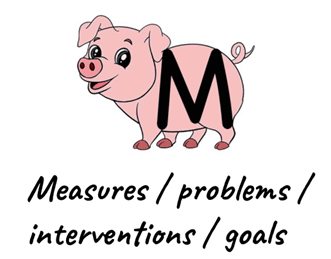
We use the aid-memoir of ‘MPIG’ (Measures, Problems, Interventions, Goals) to help keep us all on track.
The success of Project-100 is dependent on every aspect of the client journey from point of referral through follow-up operating smoothly and efficiently. This involves clarity and cooperation of all members of the team; from the administration staff at the charity communicating clearly with new referrals about how the charity works, about the help that’s on offer and, importantly, about the expectations on the cooperation of the client to participate in the process. Ensuring clients understand the rationale behind, for example, why they are asked to complete measures before and after treatment, is paramount to success. Following the screening process, when a client is referred to a treating Human Givens therapist, clearly explaining the expectations to the therapist around all the steps involved so that they know what needs to be done at every session is critical. Finally, when an episode of therapy is completed, the transition to the follow-up team who will track the client for at least 12 months following completion, needs to be handled carefully and efficiently.
Full use is made of communication tools like Youtube and shared documents on Google Drive to provide clear instructions to therapists. Online meetings with therapists and administrators are conducted where any additional challenges arise. Data quality are continuously monitored and any gaps are identified. The need to maintain morale across all who are involved is seen as critical to the success of the project. The smooth flow of the client journey is critical to the provision of a truly accurate reflection of the activity of the charity in respect of the treatment of veterans. All new referrals, whether they be self-referred (the majority) or referred by other organisations, who opt to proceed to a screening appointment are automatically included in the study.
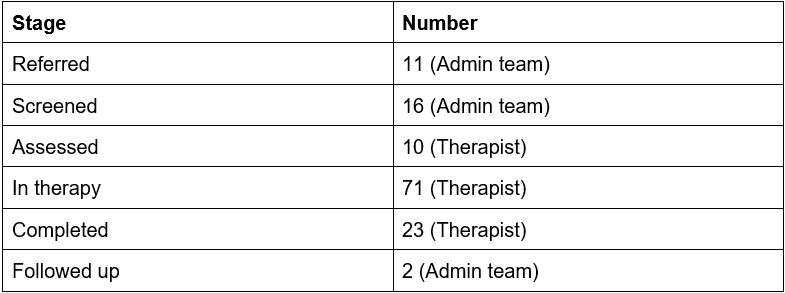
Typically, following screening by admin, should clients request to see a therapist they will be offered an assessment and up to six treatment sessions. If therapists feel the client is likely to gain additional benefit from additional sessions they may request them. Furthermore, it’s made clear to clients that the door is always open should they feel the need to contact the service again in the future.
Early analysis has been conducted on completed cases to get some indication of the progress of the project. Various hypotheses are to be tested:
- Change can be measured as satisfactorily by CORE-10 (a 10 item tool that PTSD Resolution has been using for well over a decade) as by the Improving Access to Psychological Therapy (IAPT) measures, GAD-7 & PHQ-9.
- The effect size of treatment when measured by a trauma specific measure (PCL-5) will be higher than more general measures.
- The effect size of treatment when measured by a needs-based instrument will be more conservative.
- Idiographic measurement of goals will demonstrate improvement in parallel with the diminishing of symptoms as measured by the nomothetic measures (referred to above).
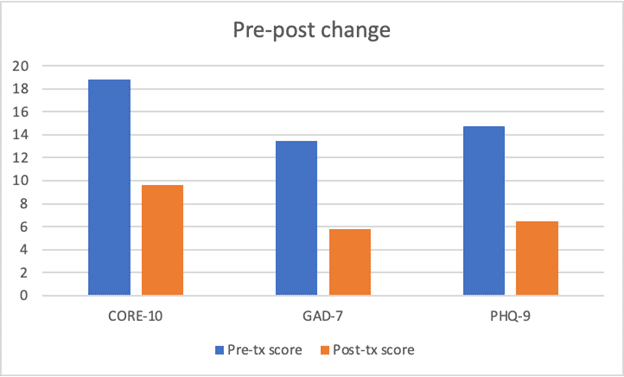
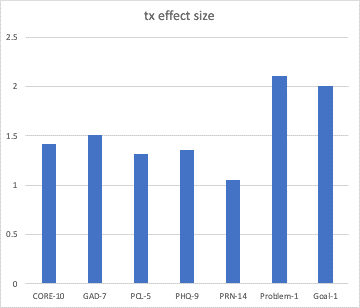
Reference to the charts provides a strong early indication that finding in favour of all hypotheses is highly likely.
Problems
In addition to use of measures, therapists explore how clients describe their problems in their own words and also how long they have been suffering from these problems. The word cloud below demonstrates clearly the dominant issues that frequently arise.
The chronicity of problems ranges from less than 3 months to more than 10 years.
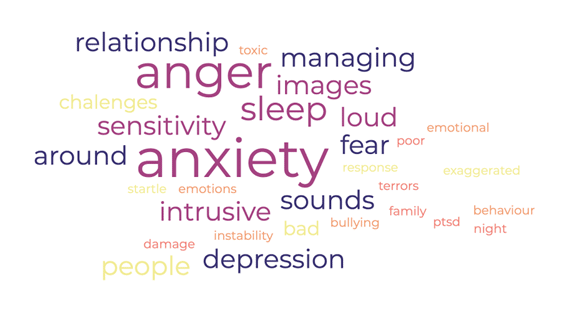
Interventions
At each treatment session therapists capture the type of interventions they have conducted with clients in the session. While a wide range of interventions is used it’s also clear that the most frequently used are; Reflective listening, psychoeducation, reframing, goal setting, highlighting resources and use of metaphor. It’s anticipated that much more will be learnt about the role of different interventions in change as time progresses.
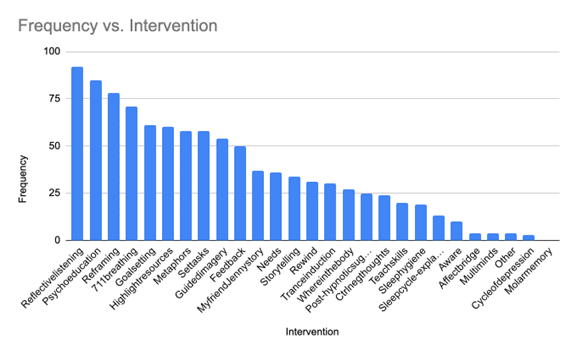
Goals
The final part that’s captured by our ‘M’-PIG is Goals. Working with goals in this more formal manner was new to many therapists and required considerable training. Many therapists have embraced this with their clients and successfully tracked and measured the client goals as described in the language of the client. The change through treatment in the scoring of the first goal identified by clients strongly indicates that as symptomes reduce and needs get met so too do goals get achieved.
Summary
With 25 completed cases, where 21 have arrived at an agreed planned ending, Project-100 is well on its way towards achieving its target of 100 such closed cases. To date, 44 Human Givens therapists are involved in treatment delivery, with many now on their 3rd or 4th case. The work continues with enthusiasm on this ambitious and comprehensive project. I look forward to reporting further on progress in the future.
Youtube Links
Latest News
Catch up with the latest news from Pragmatic Tracker here



